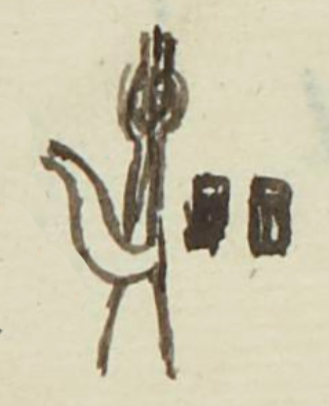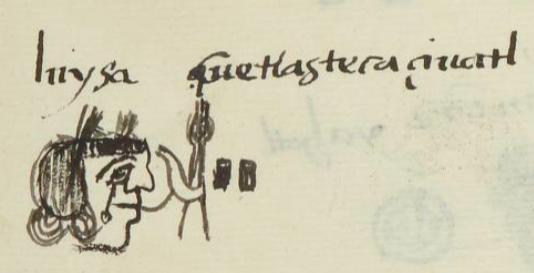Cuetlachteca Cihuatl (MH608r)
Cuetlachteca Cihuatl (MH608r)
This black and white drawing of the compound glyph for the personal name or ethnic designation, Cuetlachteca Cihuatl, is attested here as pertaining to a woman. The woman part is on the right, where the parallel vertical lines of one of the "hua" syllables is represented by the verb huahuana (to make stripes) or xahualli (face paint). The part of the compound that appears on the left must represent Cuetlachteca, but it is unclear yet how it does that. It looks something like a navigational tool, such as a divider or caliper.
Stephanie Wood
According to Danièle Dehouve, these lines represent rain drops as expressed in face paint (xahualli), and they provide the phonetic element for "hua." Dehouve also points to the possibility of tlaolxahualli, facial paint from rubber, to provide the "hua." [See, Dehouve, "The Rules of Construction of an Aztec Deity," Ancient Mesoamerica, 31 (2020), 7–28. See, in particular, page 15. She also mentions Lacadena's proposal of the verb huahuana, "to make lines in the earth, make lines on paper."] Presumably, liquid rubber could be painted on the face to create these thick black lines about the width a finger would make.
Alfonso Lacadena has called this glyphic element the Tenochtitlan-Tlatelolco "double-stroke sign." [See his article, "The wa1 and was2 Phonetic Signs and the Logogram for WA in Nahuatl Writing," The PARI Journal 8:4 (2008), 38.] Lacadena cites Karttunen 1992 in suggesting the verb huahuana. Leonardo Manrique felt the "hua" sign could be translated as "owner, possessor," but as Lacadena points out, it does not work in all cases. Sometimes it is a logogram and sometimes is is a phonogram in a complement role. It is interesting to me that the double-stroke sign is a reduplication that is both alphabetic and hieroglyphic.
Lacadena also writes about a hua "leaves sign" associated with Tetzcoco that involves two leaves (a phonogram) and a grasping hand (for possessor) hua sign, which he sees as conveying "meaning and sound."
Stephanie Wood
luysa Cuetlastecaçihuatl
Luisa Cuetlachtecacihuatl
Stephanie Wood
1560
Jeff Haskett-Wood
etnicidades, mujeres, Golfo, tecnología, cartografía

Cuetlachteca, a Gulf Coast ethnicity, https://nahuatl.wired-humanities.org/content/cuetlachteca
huahuana, to make stripes, https://nahuatl.wired-humanities.org/content/huahuana
xahual(li), face paint, https://nahuatl.wired-humanities.org/content/xahualli
tlaolxahual(li), liquid rubber face paint, https://nahuatl.wired-humanities.org/content/tlaolxahualli
Cuetlachteca-Mujer
Stephanie Wood
Matrícula de Huexotzinco, folio 608r, World Digital Library, https://www.loc.gov/resource/gdcwdl.wdl_15282/?sp=298st=image.
This manuscript is hosted by the Library of Congress and the World Digital Library; used here with the Creative Commons, “Attribution-NonCommercial-ShareAlike 3.0 License” (CC-BY-NC-SAq 3.0).




